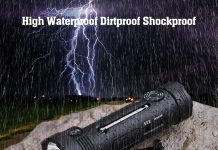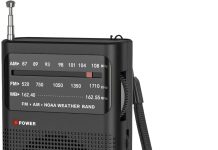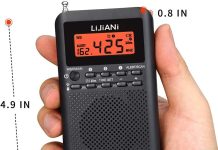When it comes to preparing for emergencies, having a reliable radio is essential for staying connected and informed. But with the multitude of options available, it can be overwhelming to decide between a handheld or stationary emergency radio. Not to worry, this article is here to help you navigate through the pros and cons of each option, ensuring you make an informed choice for your emergency preparedness needs. So whether you’re a seasoned survivalist or a concerned citizen looking to be prepared, keep reading to find out which type of emergency radio is the right fit for you.
Review contents
Factors to Consider
Portability
When it comes to emergency radios, portability is a crucial factor to consider. Handheld radios are much smaller and lightweight, making them easy to carry with you wherever you go. They can easily fit in your pocket or backpack, allowing you to have constant access to emergency communication. On the other hand, stationary radios are bulkier and less portable. They are designed to be kept in one location, such as your home or office, providing a reliable source of communication during emergencies.
Power Source
Another important factor to consider is the power source of the emergency radio. Handheld radios usually run on batteries, which means you will need to make sure you have spare batteries on hand. Some handheld radios also offer the option to be charged via USB or solar power, providing alternative power sources. Stationary radios, on the other hand, are typically powered by electricity or have a built-in rechargeable battery. This means you won’t have to worry about constantly replacing batteries, but you will need access to electricity or backup power during emergencies.
Range Coverage
The range coverage of an emergency radio is crucial in determining its effectiveness. Handheld radios generally have a shorter range compared to stationary radios, which are equipped with more powerful antennas. If you anticipate needing communication over long distances, a stationary radio with a larger range coverage would be more suitable. However, if you mainly need communication within a smaller area or for shorter distances, a handheld radio will suffice.
Antenna Options
The type of antenna available on an emergency radio can significantly impact its performance. Handheld radios usually have a built-in antenna that is sufficient for most situations. However, some models offer the option to connect an external antenna for increased range and signal strength. Stationary radios, on the other hand, often come with larger and more powerful antennas, providing better reception. If you live in an area with weak signals or anticipate needing extended range, a stationary radio with multiple antenna options may be the better choice.
Weather Resistance
Emergency radios should be able to withstand various weather conditions, especially during critical situations. Handheld radios usually come with some level of weather resistance, such as being water-resistant or shockproof. This makes them more durable and reliable during outdoor emergencies or harsh weather conditions. Stationary radios, on the other hand, may not have the same level of weather resistance since they are designed to be kept indoors. It’s important to consider the environmental conditions in which you will use the radio and choose one that can withstand those conditions.
Handheld Emergency Radios
Pros
Handheld emergency radios have several advantages that make them a popular choice for many people. Their compact size and lightweight nature make them extremely portable and easy to carry around. You can conveniently have it with you at all times, ensuring you have access to emergency communication whenever needed. Handheld radios are also relatively simple to operate, with user-friendly interfaces that allow for quick and easy communication. They are ideal for outdoor activities, such as camping or hiking, where portability is essential.
Cons
While handheld emergency radios have many benefits, they also come with some drawbacks. The range of handheld radios is usually shorter compared to stationary radios, limiting their effectiveness over longer distances. In areas with weak signals, the range may be further reduced, making it difficult to communicate with others. Additionally, handheld radios often rely on batteries for power, which means you need to have spare batteries on hand. This can be inconvenient, especially during extended periods of use or in situations where battery availability is scarce.
Stationary Emergency Radios
Pros
Stationary emergency radios offer a reliable source of communication within a fixed location. They are usually more powerful than handheld radios, allowing for longer range coverage. This makes them suitable for communicating over larger distances or in areas with weak signals. Stationary radios are often designed with additional features, such as multiple antenna options and multiple power sources. They are also more likely to have a larger display and interface, making it easier to operate and monitor important information.
Cons
The main drawback of stationary emergency radios is their lack of portability. They are not designed to be carried around, which limits their usefulness in situations where you need to move or evacuate quickly. Stationary radios are also typically bulkier and require a reliable source of electricity, which may not be available during power outages or other emergency situations. Additionally, the more advanced features and larger size of stationary radios usually come with a higher price tag, making them a more significant investment.
Comparison and Evaluation
Purpose and Usage
Before choosing between a handheld or stationary emergency radio, consider your specific purpose and usage. If you are primarily looking for a radio to use during outdoor activities or to carry with you at all times, a handheld radio would be more suitable. On the other hand, if your focus is on establishing a reliable communication system in a fixed location, such as your home or office, a stationary radio would be the better choice.
Emergency Preparedness Plan
Your emergency preparedness plan should play a significant role in determining the type of emergency radio you need. Consider factors such as the size of your location, the number of individuals who need to be communicated with, and the potential range you need to cover. If you live in a small apartment with minimal communication needs, a handheld radio may be sufficient. However, if you have a larger property or live in an area prone to natural disasters, a stationary radio with a wider range and more features would be advisable.
Frequency of Use
Think about how frequently you anticipate using the emergency radio. If you only need occasional communication during outdoor activities or infrequent emergencies, a handheld radio would be a cost-effective option. However, if you live in an area with frequent storms or other emergencies, or if you need constant communication for your job or personal circumstances, investing in a more powerful stationary radio may be more practical in the long run.
Cost
Initial Investment
The cost of an emergency radio can vary significantly depending on the type and features it offers. Handheld radios tend to be more affordable, with prices ranging from $20 to $100 depending on the brand and additional features. Stationary radios, on the other hand, can range from $100 to $500 or more, depending on the quality, range, and added features. Consider your budget and the importance of additional features when making your initial investment.
Additional Costs
In addition to the initial investment, it’s essential to consider any additional costs associated with owning an emergency radio. Handheld radios often require replacement batteries, which can add up over time. Some handheld radios can be charged using USB or solar power, reducing the need for batteries. Stationary radios may require additional accessories such as external antennas or backup power supplies, which can increase the overall cost. Factor in any additional costs to determine the long-term affordability of the radio option you choose.
Additional Features
Built-in Flashlight
Many emergency radios, both handheld and stationary, come with a built-in flashlight. This can be a valuable feature during power outages or when navigating in the dark. Consider the brightness and battery life of the flashlight when evaluating the usefulness of this feature.
SOS Function
Some emergency radios offer an SOS function, allowing you to send out distress signals in emergency situations. This feature can be especially beneficial during outdoor activities or when stranded in remote locations. Evaluate the effectiveness and ease of use of the SOS function when comparing different radios.
Battery Life
The battery life of an emergency radio is an essential consideration, especially during extended power outages or emergencies where access to electricity is limited. Look for radios with longer battery life or those that offer alternative power sources such as solar panels or hand crank charging.
Audio Quality
The audio quality of an emergency radio can greatly impact its usability. Clear and loud audio is crucial for effective communication, especially in noisy or chaotic situations. Look for radios with good audio quality to ensure you can hear and be heard during emergencies.
User-Friendliness
Ease of Operation
During emergencies, every second counts, so it’s important to have an emergency radio that is easy to operate. Handheld radios, in general, are designed for simplicity and ease of use. Look for radios with clear and intuitive controls that allow for quick access to necessary functions. Stationary radios often have larger displays and more advanced interfaces, which can be advantageous if you are comfortable with technology.
Display and Interface
Consider the size and quality of the display and interface of the emergency radio. A clear and easily readable display is essential, especially in low light or stressful situations. The interface should be intuitive and user-friendly, allowing you to navigate through menu options and adjust settings without confusion or frustration.
Manufacturer and Brand
Reputation and Reliability
The reputation and reliability of the manufacturer and brand are important factors to consider when choosing an emergency radio. Look for brands with a proven track record of producing high-quality and dependable radios. Reading customer reviews and checking for industry certifications can help ensure you are choosing a reliable product.
Customer Support
In case you encounter any issues or have questions regarding your emergency radio, it’s important to have reliable customer support. Look for manufacturers that offer comprehensive customer support, including technical assistance and warranty coverage. A responsive and helpful customer support team can make a significant difference during emergency situations.
Personal Preferences and Requirements
Comfort and Weight
Consider your personal comfort and preferences when choosing between a handheld or stationary emergency radio. Handheld radios are lightweight and easy to carry, making them comfortable for those who prioritize portability. Stationary radios, although not intended to be carried, should be compact enough to fit in your designated location without becoming a hindrance.
Accessories Availability
Check the availability of accessories for the emergency radio you are considering. Handheld radios often have a wide range of compatible accessories, such as carrying cases, external antennas, or alternative power options. Stationary radios may also have accessories to enhance their functionality, such as external speakers or remote control. Availability of accessories can add to the convenience and versatility of your emergency radio.
Final Considerations
Research and Reviews
Before making your final decision, it’s crucial to conduct thorough research and read customer reviews. Look for reputable sources that provide unbiased information and real-life experiences. Hearing from other users can give you valuable insights into the performance and reliability of different emergency radios.
Budget Allocation
Consider how much you are willing to invest in an emergency radio and allocate your budget accordingly. Determine which features and functionalities are essential for your needs and prioritize them when comparing prices and options. Keep in mind that while a higher-priced radio may offer more advanced features, it may not always be necessary for your specific requirements.
Compatibility
In addition to all the factors mentioned above, it’s important to ensure that the emergency radio you choose is compatible with your existing communication devices, such as smartphones or other radios. Check for compatibility with specific frequencies or communication protocols to ensure seamless integration with your emergency communication system.
Choosing between a handheld or stationary emergency radio is a matter of personal preference and specific requirements. By considering factors such as portability, power source, range coverage, antenna options, weather resistance, and additional features, you can make an informed decision. Evaluate your purpose and usage, emergency preparedness plan, and frequency of use to determine the most suitable option. Consider the initial investment, additional costs, ease of operation, and audio quality when assessing the user-friendliness of the radio. Research the reputation and reliability of the manufacturer and brand, and ensure that appropriate customer support is available. Take your personal preferences and requirements into account, including comfort and weight, as well as the availability of accessories. Finally, read reviews, manage your budget, and ensure compatibility before making your final decision. With these comprehensive considerations in mind, you can choose the right emergency radio that meets your needs and provides reliable communication during critical situations.




























